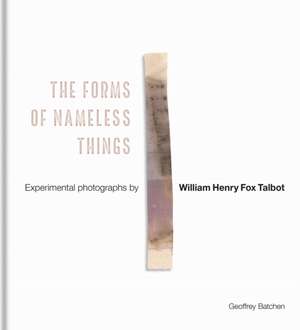The Forms of Nameless Things: Experimental Photographs by William Henry Fox Talbot
Autor Geoffrey Batchenen Limba Engleză Hardback – 10 noi 2022
William Henry Fox Talbot, the English inventor of photography, created around 15,000 photographs in the nineteenth century, most of them attempts to produce compelling scientific documents or pictorial records of the world around him. However, among his surviving works are also prints in which an image has been obscured, obliterated, or simply failed to register. All that remains on these pieces of photographic paper are chemical stains or imprinted patterns or shapes.
Borrowing its intriguing title from a poem written by Talbot, this book features twenty-four of these prints, originally intended as test prints or creative exercises. Offered to the reader as enigmatic physical artifacts, these failed or ruined photographs are here reanimated as objects of beauty, mystery, and promise, as artworks that speak of photography’s most fundamental attributes and potentials.
An accompanying essay places these photographs in a broad historical context, revealing what relevance they have to the contemporary art of photography.
Preț: 218.09 lei
Nou
41.74€ • 43.02$ • 35.24£
Carte disponibilă
Livrare economică 10-24 februarie
Livrare express 24-30 ianuarie pentru 39.69 lei
Specificații
ISBN-10: 1851245936
Pagini: 80
Ilustrații: 32 color plates
Dimensiuni: 235 x 260 x 13 mm
Greutate: 0.68 kg
Editura: Bodleian Library, University of Oxford
Colecția Bodleian Library, University of Oxford
Notă biografică
Extras
There are about 15,000 photographs attributed to Talbot, most of them attempts on his part to produce compelling pictorial records of the world around him. Understandably, existing accounts of his career tend to reproduce the best (and best preserved) of these photographs. But Talbot also undertook a lot of private investigations of photographic chemistry during that career, and made numerous tests to perfect his various processes and techniques. In other words, to make good photographs he first had to take imaginative risks, try new things and produce a certain number of informative failures. This book showcases just a few of these marginal photographs. The selection is intended to be representative of the different kinds of photographic experiments Talbot undertook. But it also offers some glimpses of those strange beauties he thereby managed to produce, the ‘forms of nameless things’ that he once conjured within his prophetic prephotographic poem ‘The Magic Mirror’.
Cuprins
Acknowledgments
Plates
Introduction
Notes
Further Reading
Picture Credits
Index
Descriere
William Henry Fox Talbot, the English inventor of photography, created around 15,000 photographs in the nineteenth century, most of them attempts to produce compelling scientific documents or pictorial records of the world around him.
However, among those that have survived are also prints in which an image has been obscured, obliterated or simply failed to register. Borrowing its intriguing title from a poem written by Talbot, this book features twenty-four of these prints, his most experimental photographs.
Originally intended as test prints or creative exercises, all that remains on these shaped pieces of photographic paper are chemical stains or imprinted patterns or shapes. Offered to the reader as enigmatic physical artefacts, these failed or ruined photographs are here reanimated as objects of beauty, mystery and promise, as artworks that speak of photography's most fundamental attributes and potentials.
An accompanying essay illustrated with comparative images places these photographs in a broad historical context leading up to the present, revealing what relevance Talbot's experiments have to contemporary concepts of the art of photography.
